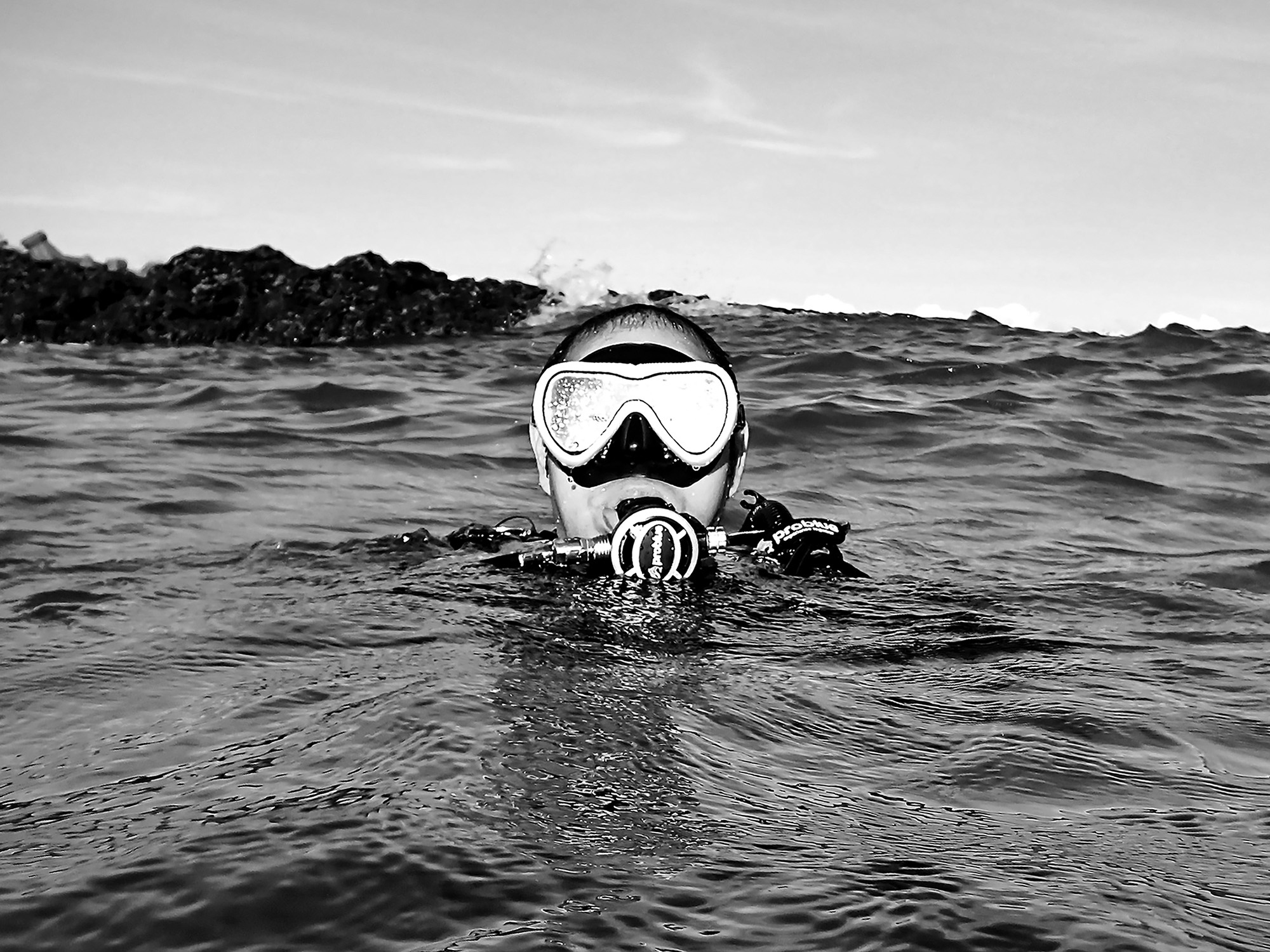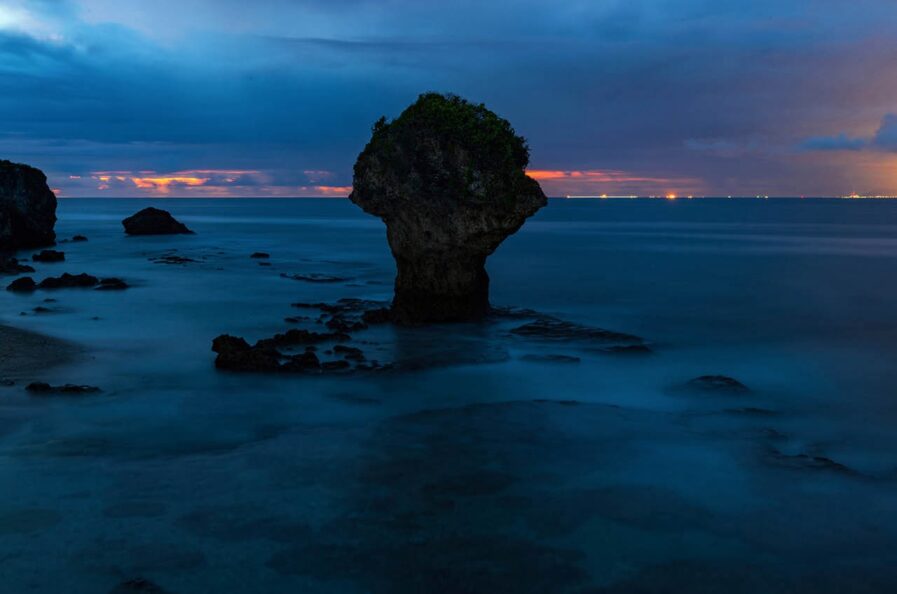Clarence Lin’s “Vase Rock (The Last Light | 花瓶岩(最後的光)” captures the fading beauty of Taiwan’s Xiaoliuqiu Island’s iconic coral formation as it transitions into night. With a long-exposure shot, Clarence highlights the quiet moment where nature stands still, revealing the landscape’s fragility and resilience. This self-initiated project, awarded Gold in the 2024 Graphis Photography Awards, is a striking reminder of the delicate balance between human presence and the natural world.
By: Clarence Lin, Photographer
“Vase Rock (The Last Light | 花瓶岩(最後的光)” captures the last light of day near the iconic landmark on Xiaoliuqiu Island. As the name suggests, Vase Rock is a coral-limestone formation resembling a vase with flowers, as ocean waves have eroded the lower section over time, leaving a broader top with vegetation.
In the summer of 2023, during the hottest year on record globally and with 2024 potentially set to surpass it, I visited the island township of Liuqiu in Pingtung County, Taiwan, commonly referred to as “Xiaoliuqiu.” Although I have visited Taiwan many times, exploring its natural landscapes and observing the impact of decades of rapid industrialization on the land, I hadn’t been to the outlying islands. After being away since the coronavirus (COVID-19) hit in 2020, I returned to Taiwan hoping to learn more about the outlying islands. While visiting the southwestern city of Kaohsiung, I began researching where to visit. I came across an article about Xiaoliuqiu, a nearby coral island, approximately 30 minutes by ferry from Dongliu Ferry Terminal in Donggang Township. I became interested in this coral island when I learned it is home to hundreds of endangered green sea turtles.
Endangered species like the green sea turtles are protected under Taiwan’s Wildlife Conservation Act. When I arrived at Xiaoliuqiu, I noticed signs around the coast advising the public to maintain a safe distance and avoid disturbing the sea turtles. More than three years into the pandemic, I hoped being surrounded by nature and in the company of sea turtles, an auspicious animal in various cultures, including Taiwan’s, would be a restorative experience. I also wanted to examine the state of the coral reefs in Xiaoliuqiu. According to reports, Taiwan experienced significant coral bleaching in 2020, and the corals have not yet recovered.
Upon arrival on the island, the more relaxed, natural setting of Xiaoliuqiu was immediately noticeable compared to the industrial city and major international port that is Kaohsiung. I rented an electric bike to explore the island, as the locals suggested this as one of the best ways to get around. The local community’s commitment to preserving the natural environment and turtle conservation is noticeably visible, not only through strict laws but also in artworks around the island, such as the mural on Benyu Road of a turtle with the words “No More Plastic!” in a speech bubble next to its mouth. In recent years, increased tourism to Xiaoliuqiu has brought economic benefits and growing concerns about its negative impact on the local environment and wildlife.
“Vase Rock (The Last Light) | 花瓶岩 (最後的光)” is one of several long-exposure photographs I took capturing the transition from day to night near that iconic location. I specifically chose to shoot the last light of the day with a long exposure to evoke the passage of time. I used a digital SLR camera, the Nikon D850, and worked with the available natural lighting in the area to create the images. One of my challenges was deciding on a location that symbolized the island, its coral reefs, and its sea turtle population and from what direction to capture that location. Another challenge was anticipating how the light would behave at the end of the day and how to capture Vase Rock in that light best. In the photograph, there is just enough light in the sky to see Vase Rock, other rock formations, and the movement of the water. During the day, the area is usually filled with people who come to the island for its beaches, clear blue waters, and the sea turtles. The last light is a time when people and sea turtles are no longer visible in that area.
In 2023, the average global surface temperature, as reported by the European Union’s Copernicus Climate Change Service (C3S) and the United Nations World Meteorological Organization (WMO), was close to 1.5 degrees Celsius above the 1850-1900 pre-industrial levels threshold, a threshold that a majority of which the world’s nations committed to respecting in the Paris Agreement. Even if global warming is limited to a 1.5°C increase above the pre-industrial average, 90 percent of coral reefs could be lost by 2050, according to the Intergovernmental Panel on Climate Change (IPCC). Coral reefs worldwide are disappearing as they face unprecedented marine heatwaves. In 2024, the U.S. National Oceanic and Atmospheric Administration (NOAA) and the International Coral Reef Initiative (ICRI) confirmed that the world is experiencing its fourth global coral bleaching event, the second in the past decade. Since early 2023, an El Niño year, mass coral bleaching has been confirmed in countries and territories worldwide.
As the light faded in Xiaoliuqiu that night, I contemplated the disappearance of one of the world’s oldest ecosystems. This image of the coral island is a reminder of the beauty and fragility of one of the most biologically diverse and essential ecosystems in Xiaoliuqiu and the world. It is an ecosystem that is in decline and could one day cease to exist.
I am honored that “Vase Rock (The Last Light) | 花瓶岩 (最後的光)” received the Gold Award in the 2024 Graphis Photography Awards, and I appreciate the opportunity to write about the journey leading up to the image.
Clarence Lin (林文睿) is an artist currently based in the United States. He holds degrees from the University of California-Berkeley and Columbia University in New York City. He is the recipient of various residencies, fellowships, and awards in the visual arts. His photographic work has been recognized by Aesthetica Magazine, American Photography, The Art Directors Club, Graphis, International Photography Awards, Life Framer, One Eyeland, and others. His artwork has been exhibited in galleries and museums and featured in publications nationally and internationally. One of the themes he often returns to in his work is the complex and ever-changing relationship between humans and the natural world, reflecting on our interconnectedness and interdependence with the natural world and what develops at the intersection of nature and urbanization.






